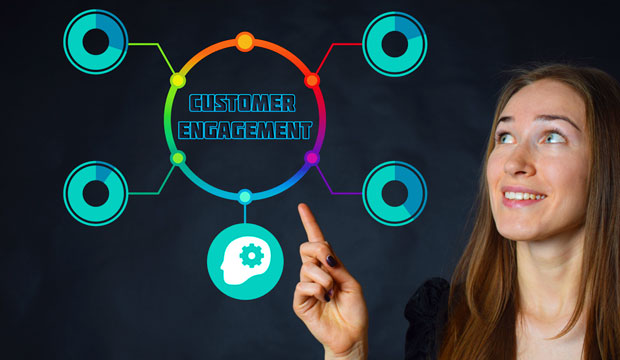The most successful brands today are those that have created engaged audiences and an exceptional customer experience. They have managed to humanize the most unsentimental of buying processes, and somehow made it look easy.
Providing a world class customer experience is so profitable that Gartner has estimated the customer experience and relationship management software market alone to be worth US$48.2 billion and rising steadily. There are thousands of options for marketers to consider, and we see new tools and market consolidation every day. It’s noisy and it’s overwhelming.
Do the Math
I think of this kind of like a math equation. There are several variables that all have various permutations that could get you to your end goal — perhaps you want to see a return on your marketing investments, or you want to activate a sophisticated cross-channel engagement strategy.
We’re constantly hearing from customers that they have several, sometimes 10 or more, tools in their “martech stacks” to achieve their goals. The trouble is, when you pull one out and put another in, the whole equation has to change. That’s not only confusing but impossible to modernize or scale.
However, to make the tools and tech the focus of this equation is to miss the point. The most important piece is the human element, and the customer should be at the center of decision-making. If customers are changing, marketers need to be able to efficiently change their technology to meet them where they are.
Customer engagement is a company-wide strategy, but marketing usually sits at the center of it all because of the need to access and interpret consumer data in a meaningful way. Smart marketers know they need to understand customers at a one-to-one level.
They want to discover hidden opportunities and immediately make changes to maximize conversion. However, sometimes — even when they have the data — that can feel like an impossible outcome.
When shopping for a customer engagement solution, marketers should focus on how they can simplify their customer engagement strategy and focus on the customer. It’s possible, and there is even a way to receive powerful analytics on each phase of a customer journey. Following are a few questions marketers can ask to ensure they will have access to the right customer insights that help them prioritize opportunities and make it all work.
1. Will This Solution Become a Money Pit?
There are customer engagement tools that promise to help you connect with your large or growing customer base, but historically vendors in this space have grown their capabilities through acquisition.
When different tools are stitched together, the integrations become complex. Disparate data sets and different code bases are prone to breakdowns. As a result, the implementations are complicated, time intensive and costly. Before you know it, you’re over budget, past your deadline, and once again further from your customers.
Unfortunately, we often see companies that adopt customer engagement platforms with implementations that become so complicated that time-to-value takes months or even years. These solutions are also very expensive, and a brand can waste hundreds of thousands of dollars or more without return. Ultimately, this mistake can cost a brand so dearly that it becomes impossible to catch up to competitors once they find the right solution.
Avoid the complex tech stack, and you will avoid fighting through drawn out implementations, broken integrations and other deployment issues. Choose a unified platform that will provide fast and effective ways to reach your customers and free you up to make your brand’s journey smooth and lucrative.
2. Am I Choosing a Solution That Works for My Customers?
It’s logical to look internally when making technology selections. You and your team are the users — and you probably have your favorite tools. The outcomes will serve your organization, and technology typically enables process. It’s important to consider all of this, but you also need to be asking if the solution has capabilities that will suit your customers.
Digital marketing messages create a ton of noise, and marketers are always fighting to be heard. Sending the right message at the right time through the right channel is what everyone strives to do.
Make sure your technology enables the personalized and connected experiences that are relevant to consumers. Sweat the details. Evaluate technology that makes it easy for you to make split decisions about each customer.
3. Do I Have a Single View of My Customers?
Related, but important to call out separately, is the single customer view. Your customer data is useless unless it’s in one place and you can make sense of it in real-time. You should be able to interpret things like purchase history, customer service history, website activity, app activity, email engagement, social media engagement, and customer lifetime value in a single place.
It becomes much easier to identify and replicate common customer journeys when you have a 360-degree view of your customers.
4. Can It Scale for Both Volume and Capability?
If you’re looking for a long-term solution, you want something that can grow with your team. Think ahead to account for your customer base growth. The more people you need to engage, the harder it will be to tailor your communications to the individual — but the expectations haven’t changed from your consumer just because you got busier.
You’ll still need to be great at one-to-one personalization at scale. Look for a solution that will let you segment your database an infinite number of ways and identify more opportunities to connect with your customers on their terms.
Then think about improvements to your program. Email may be an effective channel for your business right now, but what about the opportunities you’re missing to introduce or reinforce your messaging elsewhere? Does your solution let you easily add and expand to what you’re doing now? A rich set of marketing and commerce capabilities in an easy-to-use platform should be a prerequisite.
5. Will I Have the Right Level of Customer Support?
Technical support is fine, but things like a smooth implementation process, ensuring your email deliverability rates always exceed expectations, and having a trusted resource when your team needs to scale up are important.
Truly engaging with your customers is hard work. Is there a reliable service team to help you get everything stood up and producing value as quickly as possible? Will the service person feel like an extension of your own team?
Pick a support team that’s committed to making sure you’re successful before, during, and after purchase. Don’t settle for standard service levels. Expect your provider to partner with you and help make you successful.
The ability to establish trust and be relatable alongside a pleasant and efficient buying process is the ultimate result when it comes to customer engagement. It’s what can turn customers into fanatics, and that level of service is now the expectation for businesses of all sizes.
One in three consumers (32 percent) said they would walk away from a brand they loved after just one bad experience, according to PwC’s “Experience is Everything” report. Brands don’t have room to get this wrong.
Only a unified platform that enables engagement across all channels, with quick implementation and a single customer view, will allow you to get your job done. Customer engagement is already a tough enough mission. Don’t let your resources overcomplicate it.













































